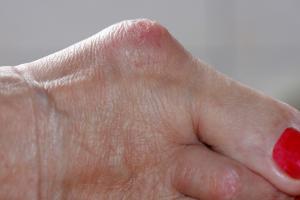Bunion
A bunion is a bony deformity of the joint at the base of the big toe. Anyone can develop a bunion. They're more common in women than men. If you have one, see your podiatrist or GP because if the bunion is left untreated, the symptoms can sometimes get worse.
Symptoms of a bunion
The main sign of a bunion is the big toe pointing towards the other toes on the same foot. This may force the foot bone attached to it to stick outwards.
Other symptoms may include:
- a swollen, bony bump on the inside edge of your foot, at the base of the big toe
- pain and swelling over your big toe joint that's made worse by pressure from wearing shoes
- hard, callused and red skin caused by your big toe and second toe overlapping
- sore skin over the top of the bunion
- changes to the shape of your foot, making it difficult to find shoes that fit

These symptoms can sometimes get worse if the bunion is left untreated, so it's best to see your GP.
Bunions are more common in women than men. This may be because of the style of footwear that women wear.
Causes of bunions
The exact cause of bunions is unknown.
Possible causes may include:
- genetics (family history)
- arthritis
- other conditions and syndromes – such as cerebral palsy and Marfan syndrome
- poorly fitting shoes
Treating bunions
A bunion may only need to be treated if it's severe and causing significant pain and discomfort.
Non-surgical treatment
If possible, non-surgical treatment for bunions will be used. Your podiatrist or GP can discuss this treatment with you.
Non-surgical treatments can ease the pain and discomfort caused by a bunion. They can't change the shape of your foot, or prevent a bunion from getting worse over time.
Non-surgical treatments include:
- painkillers
- bunion pads
- orthotics
- wearing suitable footwear
Surgery
Surgery is the only way to correct a bunion.
A bunion will usually get worse over time. If it's left untreated it's likely to get bigger and become more painful.
Surgery may be considered if your symptoms are severe and don't respond to non-surgical treatments.
Complications
If bunions aren't treated, they can lead to further problems. For example, they can cause arthritis in your big toe and push your second toe out of place.
Problems can also develop after bunion surgery.
While surgery is usually effective, bunions can sometimes return.
There is no guarantee that the foot will be perfectly straight or pain-free after surgery.
Preventing bunions
The best way to reduce your chances of developing bunions is to wear shoes that fit properly. Shoes that are too tight or have high heels can force your toes together.
Bunions are rare in populations that don’t wear shoes.
Make sure your shoes are the correct size, and that there's enough room to move your toes freely.
It's best to avoid wearing shoes with high heels or pointy toes.
More useful links
The information on this page has been adapted from original content from the NHS website.
For further information see terms and conditions.